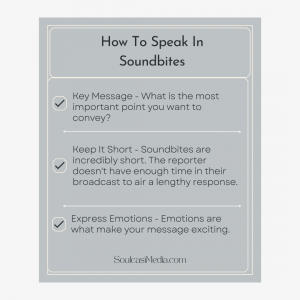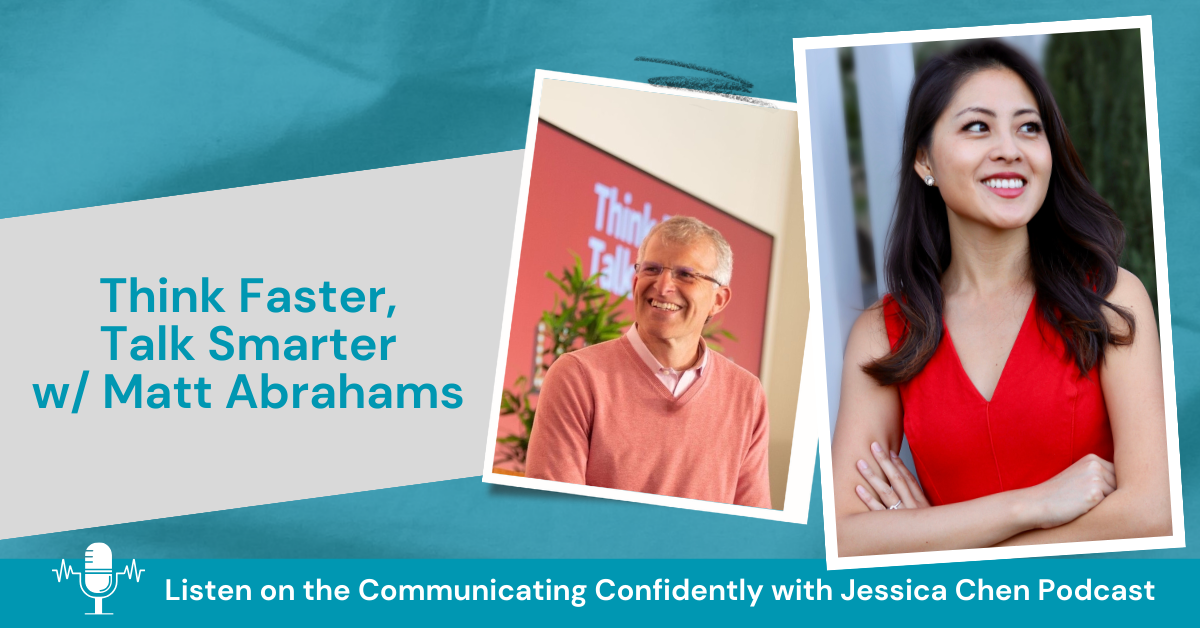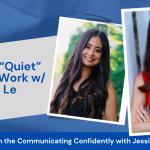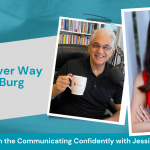How To Speak In Soundbites
One of the most important things to know about media interviews is, how much of it is actually used. You can sit for a twenty-minute interview, but only two minutes of your speaking will actually be used.
Below we will go over what soundbites are, and how you can identify which statements will be used over others.
Soundbites
Soundbites are concise and emotional statements that convey the speaker’s thoughts and feelings. Which soundbites are chosen is decided by the reporter. This is because the soundbites will be used to tie their thoughts with yours. For the person being interviewed, this means preparation really is key.
1. Key Message
As you prepare for your media interview, consider your key message. In other words, what is the most important point you want to convey? Once you’ve determined what your message is, you can incorporate it into all of your responses.
Consider the following:
- Simplicity – When brainstorming your key message, you will want to keep the message simple and easy to understand. This will allow you to incorporate your key messaging in all of your responses. The reporter will also be more likely to include your key message when your segment airs in a soundbite. For example, a simple key message could be how your company gives everyone access to home health. Try not to overcomplicate your key message.

- Multiple Responses – You will want to make sure all of your responses point to your main message. For example, let’s say your key message is speaking about the growth of your company. You will want to think about how many different ways you can convey that message. Or, if the interview is about your company’s product, you will want to come up with different ways to showcase how innovative your product is. Making sure your message always has this theme, will ensure it gets translated into a soundbite.
Your key message is what you want the audience to hear. Be sure you prepare your message and incorporate it as often as possible during your interview.
2. Keep It Short
Generally, soundbites are incredibly short. This is because the reporter doesn’t have enough time in their broadcast to air the entire interview or a lengthy response. Because of this, you will want to keep your responses concise.
![]() Consider the following:
Consider the following:
- Don’t Over Explain – Don’t feel the need to educate, or over-explain yourself. Often, people being interviewed answer a question, and they continue to go on and on. It comes across as if you need to defend and explain your answer when you do this. If you do this, your core message can get lost. Keep in mind, the longer you answer, the more diluted your message gets. Plan to share your idea, qualify it with maybe one or two sentences, but stop there.
- Avoid Filler Words – You don’t want your message to get lost in a bunch of filler words. Filler words are words such as um, ah, like, you know, etc. These words distract from your key message, and can lengthen your answers. When you have too many filler words, your responses come across as less professional, and the reporter may not be able to use your responses. One way you can work on avoiding filler words is to record yourself. Listen to yourself giving answers and work on cutting out those filler words.
Keeping your message short and to the point will pack the biggest punch.
Keeping your message short and concise will up your chances of your key messaging being translated into a soundbite. If the reporter needs an explanation, they will ask you follow-up questions.
3. Express Emotion
Emotions are what make your message exciting. The media wants to capture compelling stories for their broadcast, and emotional responses give them this. How you feel about your message is the essence of a great interview.
As you prepare for your media interview, consider the following:
- Be Comfortable Expressing Emotions – Once you’ve determined what your message is, be comfortable expressing emotions when describing it. This may feel uncomfortable, especially if you are feeling nervous. However, reporters tend to gravitate towards answers where emotions are involved. To them, hearing and seeing emotions is a cue to perk up and listen because there is gravity behind the answer. For example, if you want to talk about how innovative your product is, say it like this: “It really hasn’t been easy, but we really believe we are at the forefront of changing the way people look at finance here.” When speaking, use emotion to emphasize words.
- Tone Of Voice – Part of giving a soundbite using emotions means varying your tone of voice. What this means is making sure your tone of voice matches your message. For example, you don’t want your answers to be monotone. You want to add inflection when appropriate to emphasize your point. When you vary your tone of voice, it can add emotions to your responses, making your responses more interesting for the listener.
The media is looking for that emotion. Because the truth is, they can find the facts themselves, but they can never speak on behalf of how you are feeling about it.
In the end, preparing your interview by identifying a theme is important. Planning how you will say it, and keeping it short and emotional, will raise your chances of getting those particular soundbites heard.
__
Whenever you’re ready, there are 3 ways we can help you:
- Discover your communications style so you know where to start. Over 4,000 people have found theirs here.
- Attend our monthly communication workshop to build communications confidence (new topics: public speaking, advocating for yourself, building credibility, etc) here.
- Get your brand in front of 43k+ people by sponsoring our newsletter or Soulcast Media | LIVE LinkedIn events [contact: hello@soulcastmedia.com]











